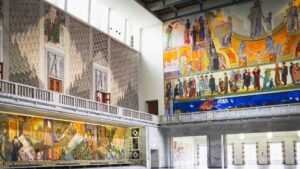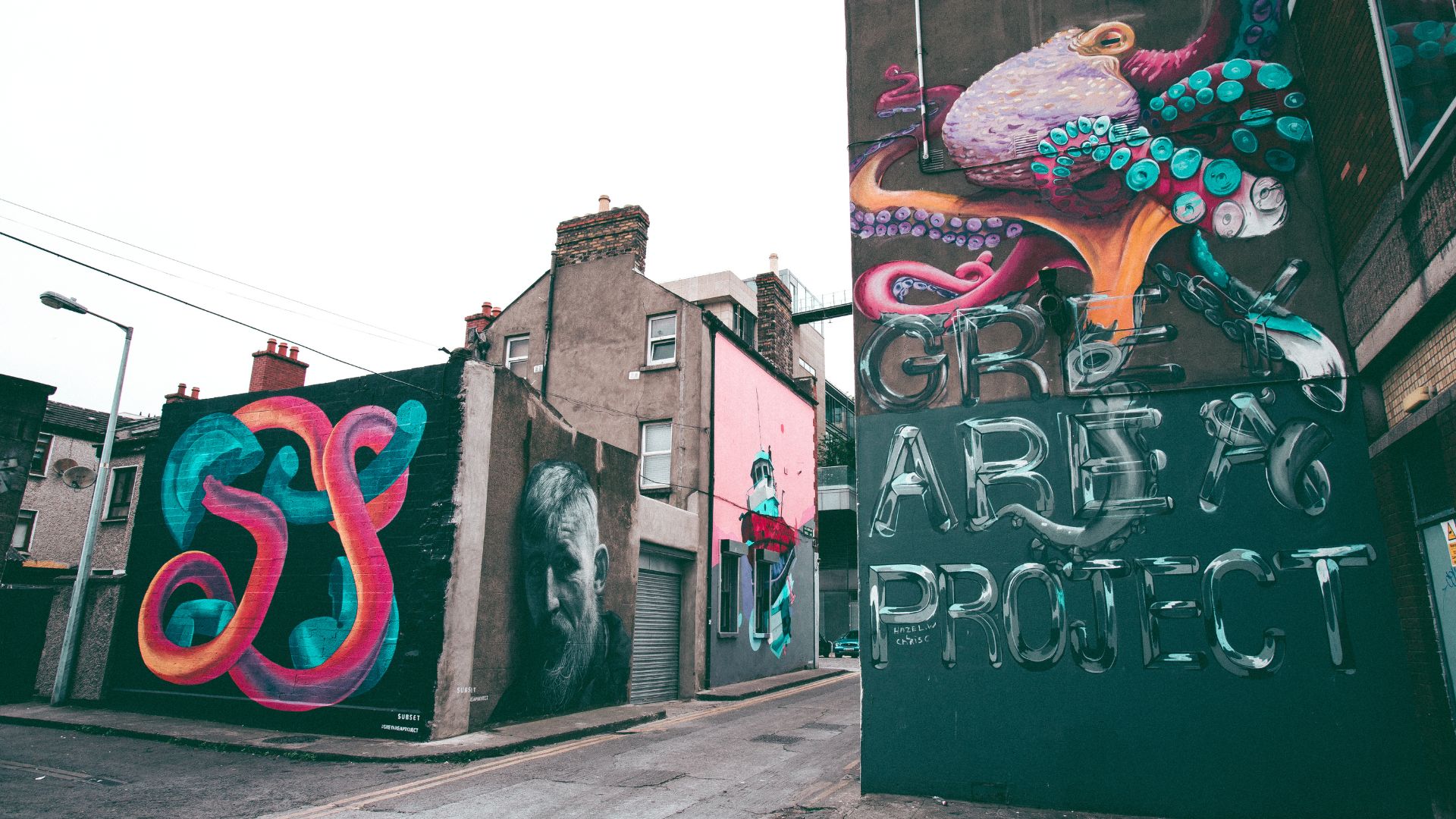Murals are vibrant expressions of art that enrich our surroundings, but exposure to the elements can threaten their longevity. Whether a street mural or an indoor masterpiece, protecting these works requires thoughtful care and techniques. Here are effective ways to safeguard murals from nature’s forces:
1. Sealants and Protective Coatings
Artists often use clear sealants or protective coatings formulated specifically for outdoor or indoor use. These shield murals from rain, UV rays, and pollution. Acrylic sealants create a transparent barrier, preserving colors while allowing the mural to breathe.
2. Regular Maintenance
Routine inspections and touch-ups are crucial. Monitor the mural’s condition periodically and address any issues promptly. Small damages, like cracks or fading, can be repaired before they escalate and compromise the artwork’s integrity.
3. Location Selection
Consider the mural’s placement carefully. If possible, avoid areas directly exposed to harsh weather conditions. Walls shielded from heavy rainfall, direct sunlight, or strong winds inherently protect the mural.

4. Anti-Graffiti Coatings
For outdoor murals prone to vandalism, anti-graffiti coatings act as protective layers. These coatings allow easier graffiti removal without damaging the original artwork. They deter vandals and preserve the mural’s essence.
5. Professional Restoration
Seek professional restoration services when necessary. Trained conservators possess the expertise to assess damage and perform restoration techniques that maintain the artist’s vision while safeguarding the mural’s longevity.
6. Community Engagement and Education
Engage the community in caring for the mural. Educate locals about the significance of the artwork and how they can contribute to its preservation. Community involvement often leads to collective efforts in protecting these cultural assets.
So,…
Protecting murals from the elements demands a proactive approach, combining suitable coatings, regular maintenance, thoughtful placement, and community involvement employing these techniques, to honor and ensure the endurance of these captivating artistic expressions for generations to come.
For further insights into mural preservation techniques and resources, check out the following external links:
- National Center for Preservation Technology and Training – Explore preservation techniques for various artworks and structures.
- Mural Arts Philadelphia – Learn about community engagement in mural preservation efforts.
- Getty Conservation Institute – Discover resources on conservation and restoration techniques for artworks.
Understanding Environmental Threats to Murals
Murals, often exposed to the elements, face various environmental challenges that can impact their longevity and vibrancy. Understanding these threats is crucial in devising effective protection strategies:
1. Sunlight and UV Radiation
Problem: Prolonged exposure to sunlight causes colors to fade and materials to deteriorate over time. UV radiation accelerates this process. Solution: UV-resistant coatings or varnishes act as a shield, reducing UV damage while preserving the mural’s colors.
2. Moisture and Humidity
Problem: Rain, moisture, and high humidity levels lead to water damage, mold growth, and material degradation. Solution: Proper sealing and waterproof coatings help prevent water infiltration. Adequate ventilation in indoor environments reduces humidity levels, safeguarding the mural.
3. Air Pollution
Problem: Pollutants like sulfur dioxide and carbon dioxide in the air can cause chemical reactions that degrade mural surfaces. Solution: Protective coatings act as a barrier against pollutants. Regular cleaning removes surface contaminants, preserving the mural’s integrity.
4. Physical Damage
Problem: Accidental impacts, vandalism, or natural wear and tear can cause physical damage to murals. Solution: Anti-graffiti coatings deter vandals, while regular inspections and prompt repairs address minor damages before they worsen.
5. Biological Threats
Problem: Algae, fungi, and moss growth on the mural’s surface can cause discoloration and structural damage. Solution: Use biocides or anti-fungal coatings to inhibit biological growth. Routine cleaning and maintenance prevent these organisms from thriving.
6. Temperature Extremes
Problem: Fluctuations in temperature, especially rapid changes, can stress mural materials, leading to cracks or warping. Solution: Properly chosen coatings and materials with good thermal stability can mitigate the effects of temperature changes.
Conclusion
Preserving murals involves a multifaceted approach that addresses environmental threats comprehensively. By understanding the challenges posed by sunlight, moisture, pollution, physical damage, biological growth, and temperature variations, one can implement tailored protective measures to ensure the longevity of these artistic treasures.
Murals are not just art; they are cultural narratives that deserve our careful attention and preservation efforts. With an awareness of environmental threats and the implementation of suitable protective techniques, we can cherish these expressions of creativity for years to come.
For further information on the environmental impact on murals and preservation strategies, explore the following external resources:
- International Institute for Conservation of Historic and Artistic Works – Explore resources on conserving cultural heritage, including murals.
- The Conservation Register – Find conservators specializing in mural preservation and restoration.
- Smithsonian Cultural Rescue Initiative – Discover initiatives and resources dedicated to preserving cultural heritage worldwide.
Understanding the threats and implementing protective measures is key to ensuring the resilience and endurance of murals against environmental challenges.
Comparison tabular
| Environmental Threats | Description | Protective Measures |
|---|---|---|
| Sunlight and UV Radiation | Prolonged exposure causes color fading and material deterioration. | – Apply UV-resistant coatings or varnishes.
– Limit direct sunlight exposure. |
| Moisture and Humidity | Rain, moisture, and high humidity lead to water damage and mold growth. | – Seal with waterproof coatings.
– Ensure proper ventilation in indoor spaces. |
| Air Pollution | Pollutants in the air can chemically degrade mural surfaces. | – Use protective coatings as a barrier.
– Regularly clean to remove surface contaminants. |
| Physical Damage | Accidental impacts, vandalism, or wear and tear cause harm. | – Apply anti-graffiti coatings.
– Conduct regular inspections and prompt repairs. |
| Biological Threats | Algae, fungi, and moss growth can cause discoloration and damage. | – Use biocides or anti-fungal coatings.
– Perform routine cleaning and maintenance. |
| Temperature Extremes | Fluctuations in temperature stress mural materials. | – Choose materials with good thermal stability.
– Apply coatings to mitigate temperature effects. |
Understanding these threats and implementing the corresponding protective measures can significantly enhance the longevity and preservation of murals against environmental challenges.
Wrapping up
Preserving murals is a commitment to safeguarding cultural heritage and artistic expressions for future generations. By recognizing the environmental threats they face be it sunlight, moisture, pollution, or physical damage we empower ourselves to protect these vibrant artworks.
Through a combination of proactive measures such as using protective coatings, regular maintenance, thoughtful placement, and community involvement, we can ensure that these visual narratives endure the tests of time.
Remember, each stroke of paint on a mural tells a story, and it’s our collective responsibility to ensure that these stories remain vivid and alive. By cherishing and actively preserving these artistic treasures, we honor the creativity and diversity that murals bring to our communities.
Let’s continue to celebrate and safeguard these colorful testaments to human imagination, ensuring that they thrive against the backdrop of the ever-changing elements. Together, we can uphold the legacy of murals and enrich the cultural tapestry of our world for years to come.

For over a decade, I’ve been Mike, an artist, crafter, and designer deeply immersed in the Croc world. I thrive on crafting unique, size-inclusive patterns, fostering creativity, and sharing them on ktforum.com. My designs aim to ignite your creative spark and delight you, ensuring clarity and ease of use through rigorous testing. Join me in expressing your creative flair and showcasing your craft with joy.
Related Posts
- Incorporating 3D Elements into Murals: A Creative Guide
Murals have long been a vibrant form of artistic expression, transforming blank walls into captivating…
- Protecting Murals from Vandalism: Effective Strategies
Murals are vibrant expressions of creativity and community, adding color and character to our surroundings.…
- Keeping Murals Vibrant: Tips to Prevent Fading Over Time
Murals are vibrant expressions of art that enrich our surroundings, but over time, exposure to…
- Exploring the Legacy of 2Pac Through Iconic Murals
When discussing the legendary rapper Tupac Shakur, his impact extends far beyond his music. One…

